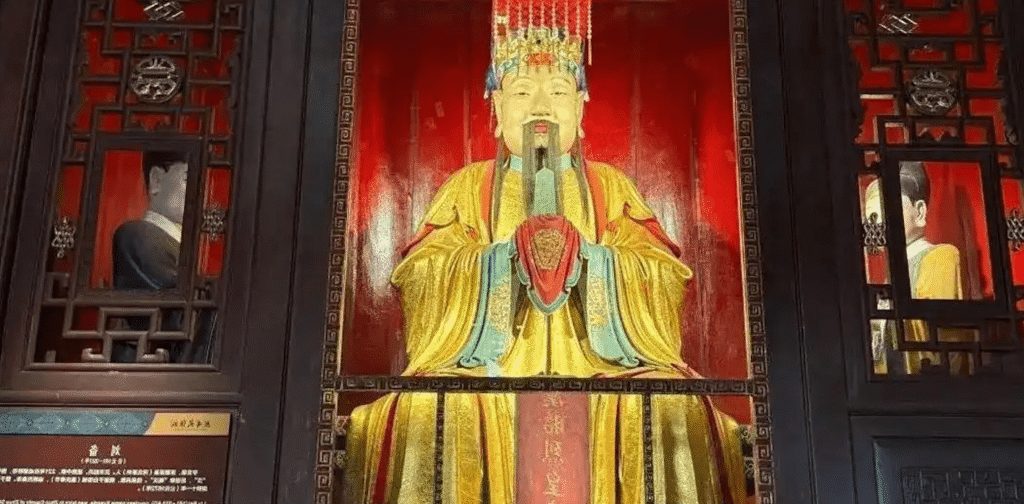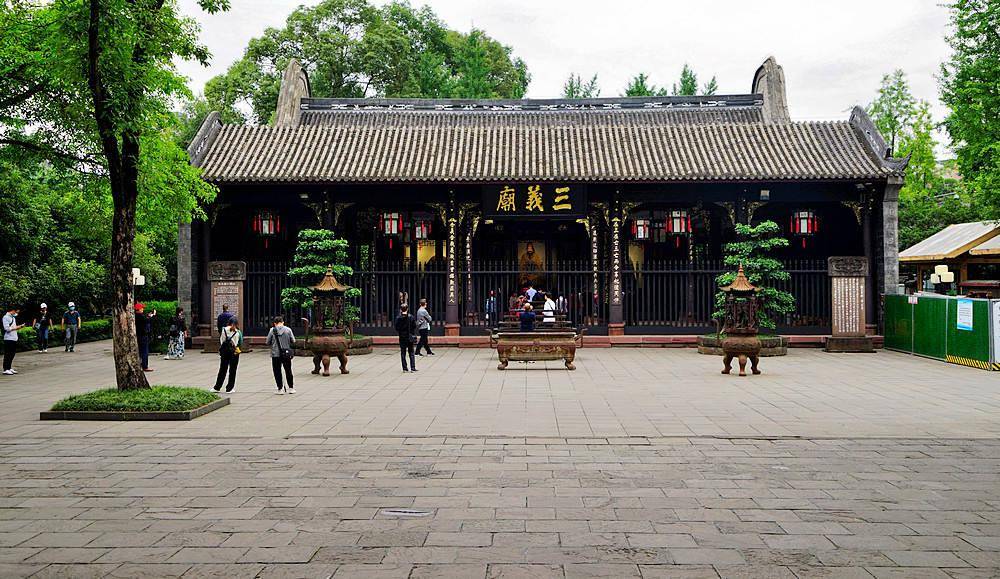Chengdu is a city with a long history and many famous attractions, and Wuhou Temple is one of the most important tourist attractions in Chengdu. It is not only an ancient temple, but also a treasure house that showcases Bashu culture and history, leading tourists to appreciate the elegance of Three Kingdoms figures such as Zhuge Liang and Liu Bei.
Wuhou Temple Facts
Wuhou Shrine was originally a shrine dedicated exclusively to Zhuge Liang. Zhuge Liang was the chancellor of Shu Han during the Three Kingdoms period and was granted the title “Marquis Wuxiang,” hence the shrine is also called Wuhou Marquis Memorial Temple.
- Name: Wuhou Temple / Wuhou Shrine / Wuhou Memorial Temple
- Type: Historical Relics Museum
- Address: No.231 Wuhou Temple Street, Chengdu, Sichuan
- Area: 150,000 square meters
- Opening Hours: 08:00 – 18:00
- Ticket Price: CNY 50 Trip.com Discounts
- Recommended Visiting Time: 2~4 hours
The Wuhou Shrine also enshrines Emperor Liu Bei, making it the only existing shrine in China that jointly honors both a ruler and his minister. Today, the Wuhou Shrine has become the most influential Three Kingdoms relics museum worldwide.
Wuhou Memorial Temple’s History
The Wuhou Shrine traces its origins to the Southern Dynasties when separate temples for Liu Bei and Zhuge Liang were built near Hui Mausoleum. During the Ming Dynasty (1391), these were merged to create China’s unique combined ruler-minister memorial complex. The present layout, featuring distinct front (Liu Bei) and rear (Zhuge Liang) halls, was established in 1672 under Qing Emperor Kangxi.
Today’s Wuhou Shrine complex is made up of three main sections including the Three Kingdoms Cultural Relics Preservation Zone, Three Kingdoms Culture Experience Zone (i.e., The West Zone, which is the former Chengdu Nanjiao Park) and the Jinli Folk Customs Zone.
What to See inside Wuhou Temple
The main structures of Wuhou Shrine complex are arranged along a north-south axis: Main Gate, Second Gate, Liu Bei Temple, Wuhou Temple and Sanyi Temple.
Hanzhaolie Temple
The Han Zhaolie Temple serves as the main entrance to the Wuhou Shrine, featuring a massive red horizontal plaque above its gate with the solemn golden inscription “Han Zhaolie Temple” in four large Chinese characters. Upon entering, visitors encounter one of the shrine’s most precious cultural relics: the Triple Excellence Stele. Created by Tang Dynasty officials – with Pei Du composing the text, Liu Gongchuo executing the calligraphy, and Lu Jian carving the characters – this remarkable stele commemorates Zhuge Liang’s exceptional statesmanship.

Temple of Liu Bei
Passing through the second gate, you reach the grand Liu Bei Temple, also known as Zhaolie Temple. Inside stands a 3-meter-tall golden statue of Liu Bei, seated with dignity. To his left is a statue of his grandson, Liu Chen. In the courtyard, statues of Liu Bei’s loyal generals Guan Yu and Zhang Fei are placed on the east and west sides respectively, each with their descendants. A small stele in front of each statue tells their story. The temple is built higher than other halls in the Wuhou Shrine, with a gentle slope carved with dragons and clouds, symbolizing Liu Bei’s imperial status.

Temple of Zhuge Liang
Behind the Liu Bei Temple lies the Wuhou Temple, dedicated to Zhuge Liang, one of China’s most revered statesmen and strategists. Entering the foyer, visitors see a large board with the three characters “Wu Hou Ci”. At the center of the temple stands a statue of Zhuge Liang holding a feather fan, dressed in golden robes that reflect his wisdom and grace. The three ancient bronze drums in front of the statue are called Zhuge drums, which are said to be used by him during his southern campaigns. On the temple’s pillars are lines from his Advice to My Son.


Sanyi Temple
The Sanyi Temple was originally located on Tidujie Street. First built during the Kangxi reign (Qing Dynasty), it was relocated to the Wuhou Shrine complex in 1997 for urban development purposes, with all original architectural components and plaques carefully preserved. The current temple complex consists of a Worship Hall, a Main Hall, and two flanking corridors. The Main Hall enshrines the revered clay statues of Liu Bei, Guan Yu, and Zhang Fei

Tomb of Liu Bei
The Hui Mausoleum (Tomb of Liu Bei) is located west of Wuhou Temple, dating back over 1,700 years. This well-preserved circular tomb (180m perimeter, 12m height) features a red-walled passage with stone sculptures leading to the main gate inscribed “Han Zhaolie Ling”. Named for Liu Bei’s benevolent rule (“Hui” meaning “kind”), the site also contains his two queens and remains surrounded by lush greenery.
Attractions Near Wuhou Temple
Jinli Ancient Street stands just a wall away from Wuhou Temple, making it an effortless next stop after your temple visit. This 550-meter-long lane, bustling since Qin times, perfectly blends old and new – traditional teahouses serving covered-bowl tea sit alongside modern bars, while craft stalls and snack vendors mingle with Sichuan Opera performances.
Three Recommended Tour Routes at Wuhou Shrine

- Two-hour Route: Han Zhao Lie Temple -> Tang Stele -> Civil Officials Gallery -> Military Generals Gallery -> Liu Bei Hall -> Zhuge Liang Hall -> Sanyi Temple -> Kongming Garden -> Hui Mausoleum -> Red Walled Alley -> Exit
- Three-hour Route: Han Zhao Lie Temple -> Tang Stele -> Civil Officials Gallery -> Military Generals Gallery -> Liu Bei Hall -> Zhuge Liang Hall -> Sanyi Temple -> Guihe Tower -> Red Walled Alley -> Hui Mausoleum -> Kongming Garden -> Jieyi Tower -> Jinli Ancient Street
- Four-hour Route: Han Zhao Lie Temple -> Tang Stele -> Civil Officials Gallery -> Military Generals Gallery -> Liu Bei Hall -> Zhuge Liang Hall -> Sanyi Temple -> Kongming Garden -> Hui Mausoleum -> Red Walled Alley -> Central Gate -> Jingzhong Gate -> Sifang Pavilion -> Wuhou Shrine Art Gallery -> Liu Xiang’s Tomb -> Jinli Ancient Street
How to get to Wuhou Temple
By Metro
Take Metro Line 3 or Line 5 to Gaoshengqiao Station (高升桥站). Use Exit A and enjoy a pleasant 10-minute walk to the Wuhou Shrine Museum.
By Bus
Take bus lines No. 1, 57, 82, 334 or 335 directly to the Wuhou Shrine Museum stop (“Wuhou Ci” station) for convenient access to this historic site.
By Scenic area shuttle
Direct shuttle buses connect Wuhou Shrine with Chengdu’s major transport hubs like Shuangliu Airport and East Bus Terminal, as well as popular attractions including Kuanzhai Alleys, Dujiangyan, and Sanxingdui Site. These comfortable tourist shuttles provide convenient transfers from downtown hotspots such as IFS Mall and Chunxi Road, operating regular daily services to the historic shrine.
Wuhou Shrine Tickets & Opening Hours
Book Wuhou Temple Tickets Now| Entrance Fee | Adults: CNY 50 Children (ages 6-18): CNY 25 Free for children under 1.3m (4.3ft) or under 6 years old and Free for seniors over 60 years old |
| Opening Hours | 09:00 – 18:00 (tickets selling stops at 17:00) |
Frequently asked questions
The Wuhou Temple tourist center provides free luggage storage services for visitors.
From Jiuli Campus, walk 400m to Jiulidi Zhonglunan station and take Bus 109 to Wuhouci Street, then walk 600m to the temple. Alternatively, a taxi costs about ¥20 and takes 10-15 minutes.
Yes, tickets are available for purchase directly at the shrine’s entrance gate.